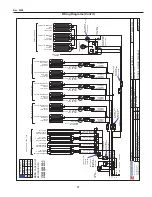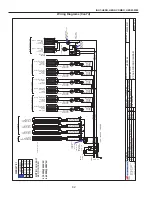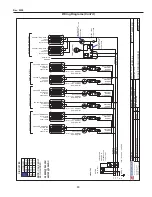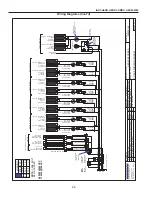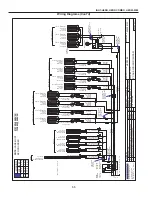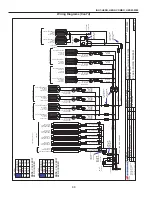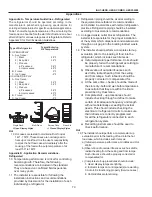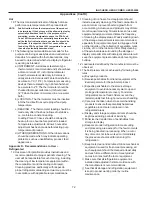
IGHT-HEDN, HEDN COMBO, HEDW-0508
72
Hot
1.0 The most consistent indicator of display hot case
performance is temperature of the product itself.
NOTE: Public Health will use the temperature of the product
in determining if the hot case will be allowed to display
potentially hazardous food. For the purpose of this
evaluation, product temperature above the FDa Food
Code 1993 temperature for potentially hazardous food
will be the first indication that an evaluation should be
performed. It is expected that all hot cases will keep
food at the FDa Food Code 1993 temperature to prevent
the sale of potentially hazardous food.
1.1 The following recommendations are made for the
purpose of arriving at easily taken and understood
data which, coupled with other observations, may
be used to determined whether a display refrigerator
is working as intended:
a) INSTRUMENT - A stainless steel stem-type
thermometer is recommended and it should have
a dial a minimum of 1 inch internal diameter.
A test thermometer scaled only in Celsius or
dually scaled in Celsius and Fahrenheit shall be
accurate to 1°C (1.8°F). Temperature measuring
devices that are scaled only in Fahrenheit shall
be accurate to 2°F. The thermometer should be
checked for proper calibration. (It should read
32°F when the stem is immersed in an ice water
bath).
b) LOCATION - The thermometer must be inserted
into the food itself to acquire proper food pulp
temperature.
c) READING - The thermometer reading should be
made only after it has been allowed to stabilize,
i.e., maintain a constant reading.
Loading Product: Cases should be allowed to
heat up for one hour before product is loaded.
Temperature adjustments: Allow 4 hours after
adjustment has been made before testing pulp
temperature of product.
d) OTHER OBSERVATIONS - Other observations
should be made which may indicate operating
problems, such as unsatisfactory product, feel/
appearance.
appendix D - Recommendations to User -
Refrigerated
1.0 Hussmann Corporation provides instructions and
recommendations for proper periodic cleaning. The
user will be responsible for such cleaning, including
the cleaning of low temperature equipment within
the compartment and the cooling coil area(s).
Cleaning practices, particularly with respect to
proper refrigerator unloading and warm-up, must be
in accordance with applicable recommendations.
1.1 Cleaning of non frozen food equipment should
include a weekly cleaning of the food compartment
as a minimum to prevent bacteria growth from
accumulating. Actual use and products may dictate
more frequent cleaning. Circumstances of use and
equipment design must also dictate the frequency
of cleaning the display areas. Weekly washing down
of the storage compartment is also recommended,
especially for equipment subject to drippage of milk
or other liquids, or the collection of vegetable, meat,
crumbs, etc. or other debris or litter. Daily cleaning
of the external areas surrounding the storage or
display compartments with detergent and water will
keep the equipment presentable and prevent grime
buildup.
1.2 Load levels as defined by the manufacturer must be
observed.
1.3 The best preservation is achieved by following these
rules:
a) Buy quality products.
b) Receive perishables from transit equipment at the
ideal temperature for the particular product.
c) Expedite perishables to the store’s storage
equipment to avoid unnecessary warm-up and
prolonged temperature recovery. Food store
refrigerators are not food chillers nor can they
reclaim quality lost through previous mishandling.
d) Care must be taken when cross merchandising
products to ensure that potentially hazardous
vegetable products are not placed in non
refrigerated areas.
e) Display and storage equipment doors should be
kept closed during periods of inactivity.
f) Minimize the transfer time of perishables from
storage to display.
g) Keep meat under refrigeration in meat cutting
and processing area except for the few moments
it is being handled in processing. When a cut or
tray of meat is not to be worked on immediately,
the procedure should call for returning it to
refrigeration.
h) Keep tools clean and sanitized. Since mechanical
equipment is used for fresh meat processing, all
such equipment should be cleaned at least daily
and each time a different kind of meat product
comes in contact with the tool or equipment.
i) Make sure that all refrigeration equipment is
installed and adjusted in strict accordance with
the manufacturer’s recommendations.
j) See that all storage and refrigeration equipment
is kept in proper working order by routine
maintenance.
appendices (Cont'd)




